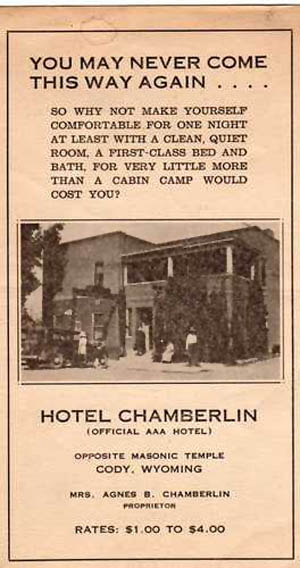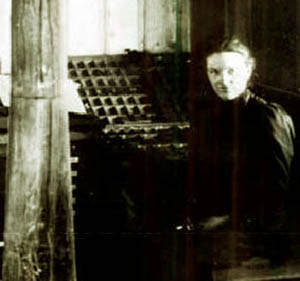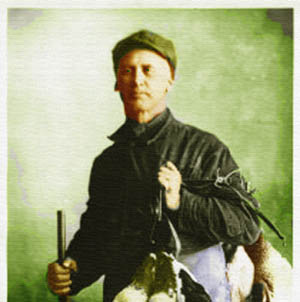|

Col. John H. Peake and Col. Cody in offices of
the Cody Enterprise.
The Cody Enterprise, still in business, was founded by Col. Cody in 1898. Its first editor was Col. John H. Peake (1848-1905).
The newspaper was housed in a false fronted two-story building heated by a stove in the backroom. The building was
later described Jo Jean Thomas DeHoney in "Life in the Hotel" as being "about as warm as a paste board box."
Below left, Advertising card Chamberlin Hotel, 1941, below right, Agnes Chamberlin in office at Cody Enterprise.
 
Below, Dr. Mark Chamberlin

Dr. Mark Chamberlin (1864-1922) and Agnes Chamberlin, nee Brown (1871-1949), arrived in Cody about 1901. Mrs Chamberlin obtained employment with the
Cody Enterprise which at the time was located on 12th Street.
Peake served on the Town Council and served as a probate commission for Big Horn County. He left Cody in 1905 for a trip
to Washington, allegedly for his health. He was born in Portsmouth, Virginia, but in
1860 his family moved to Washington City. At age 14, he enlisted in the Union forces. He served as an aide to
George Armstrong Custer and was wounded at the Battle of the Wilderness. He was a member of
the Masons, the Grand Army of the Republic, the Shoshone Tribe of the Improved Order of Redmen, and
Bear Tooth Lodge of the Elks. At his funeral in Washington, the Masonic Quartet sang "Abide with Me,"
and "Lead Kindly Light." The service concluded with "Nearer My God to Thee," the background music for this page [Information as to Peake from the
Washington Star obituaries published between November 29, 1905, and
December 5, 1905.]

Cody Enterprise, approx. 1905.
Following Col. Peake's death, the newspaper was sold. From 1908 until 1941 the building housed
Dave Shelley's [David P. Shelley, 1868-1941] saddle and leather goods shop. Shelley advertised his shop as "makers of the famous Cody Stock Saddle." He also made
chaps [both bat wings and angora], jackets and other leather gear.
Dave was a member of the Cody Eagles Aerie and served as "Worthy President" in 1910. In 1945, the shop was sold.

Dave Shelley's harness shop, undated.The rider is believed to be
Shelley.
The faint sign on the left with its bizarre spelling of bazaar in photo with reflection in window is depcited in next photo.

Sign on harness shop, undated.
Following 1945, the building was occupied by Ed McNeely until his death about 1977. The building was razed in 1979. The building on the right was the photographic shop and studeo of F. J. Hiscock.

Photography studio of F. J. Hiscock.
Joseph Jesse Faver "Fay Jay" Hiscock (F. J. Hiscock, 1874-1951), many of
whose pictures are featured on these pages, was originally from Kalamazoo,
Michigan. He remained active in photography in Cody from his arrival
in 1904 until the early 1940's, and sold packages of photographs to
tourists. The packages were primarily of the Cody Road. In his advertising
he referred to himself as "The Picture Man."

Ed McNeely's "Cowboy Outfitters," undated. McNeely on right. Cowboy holding rope
unidentified.

Ed McNeely's "Cowboy Outfitters," undated. McNeely in front.
The Chamberlins arrived in a sheep wagon which they had purchased in Nebraska. The two had met in Woodward, Oklahoma. Woodward was a part of the Oklahoma Strip where the future Mrs.
Chamberlin was working in a printing office and Mark Chamberlin was practicing dentistry in Woodward, Oklahoma Territory. Dr. Chamberlin had
graduated from the University of Nebraska with a degree in law in 1892. He
then attended and graduated from the Kansas City Dental College in
1897. See Polk's Dental Directory 1914, p. 1060. However, as discussed below there is some question as
to his graduation.
In Oklahoma Territory at the time temporary licensure was not permitted nor were licenses issued without examination.
It was not necessary to have a diploma from a dental
school or experience to take the examination. Dr. Chamberlin failed the examination.Thus accounting for Dr. Chamberlin's departure from
Oklahoma Territory.
The couple married in 1899 in Peabody, Kan. and from there proceeded westward toward Wyoming.
Before their arrival in Cody there were brief sojourns in Douglas, Hartville, and Thermopolis. In Cody, the couple constructed a lodging house
on a previously vacant lot across 12th Street from where the Masonic Temple is presently located. Dr. Chamberlin was a member of Shonsone Lodge No. 21.
A dental office was built
to the north of the Lodging house. Dr. Chamberlin at first used a barber chair for the dental chair. As was common at the time, in addition to his practice, Dr.
Chamberlin "rode circuit" making visits to Powell, Meeteetse and Basin, advertising his visits in local newspapers.Indeed,
following his death from cancer in Powell, August, 1922, one ad appeared in the Meeteetse News,September 9, p. 4. Dr. Chamberlin also wrote at least one
learned article for publication. See "Method of Making Richmond-Davis Crowns," 28 Journal of Dental Science, Art and Literature 183. He was a member of the
first Town Council upon the formation of the Town. His funeral was conducted by the Masonic Lodge.

Chamberlin Hotel, 1920's.
Slowly the lodging house expanded until by 1917 it was a hotel. The upstairs porch as since been closed in.
During renovations in recent years brick interior walls were found which trace the expansion of the
hotel over the years. Expansion of the hotel was completed in 1917. Later, after Dr. Chamberlin's death in
1922, Mrs. Chamberlin contended that the couple had little in common, She had married Dr. Chamberlin only for security. She also contended that
Dr. Chamberlin's diploma was forged. See "Life in the Hotel," supra. By 1920 Dr. Chamberlin was living at 216 W. Rumsey Ave.
Mrs. Chamberlin continued to operate the hotel until it was sold in 1939 and became the Pawnee Hotel. The hotel has since been renamed to the
Chamberlin Inn. Mrs. Chamberlin died in in 1949 from a coronary occlusion.
Background music for this page "Nearer My God to Thee," composed by Lowell Mason (1792-1872) with lyrics by Sarah P. Adams (1805-1848). The version here was sung by famed contralto Earnestine Schuman Heink (1861-1936) and recorded by the
Victor Talking Marchine Company. The hymn is most noted as being alegedly the last song played by the
ship's band of the Royal Mail Ship Titanic as she went down.
Next page: Etta Feeley's "Big White House," the "Green House," Miss Cassie's house, the Downfall of Dr. William S. Bennett.
|